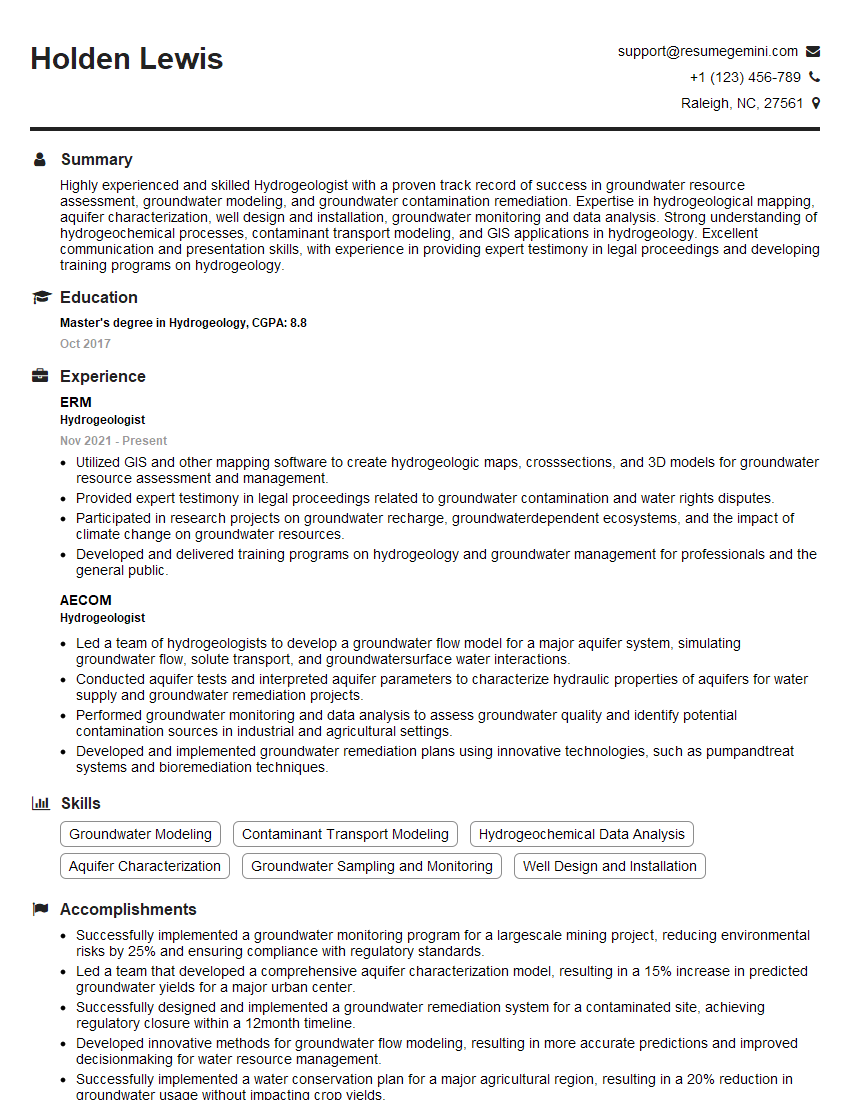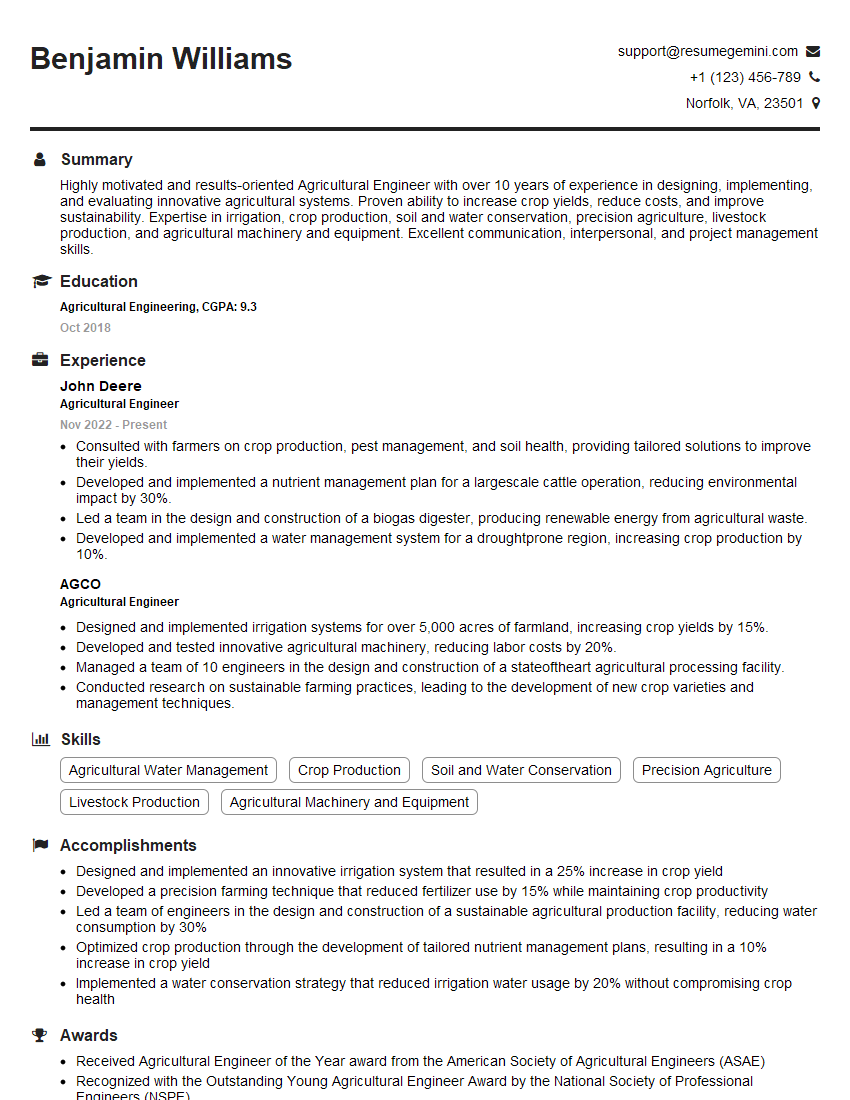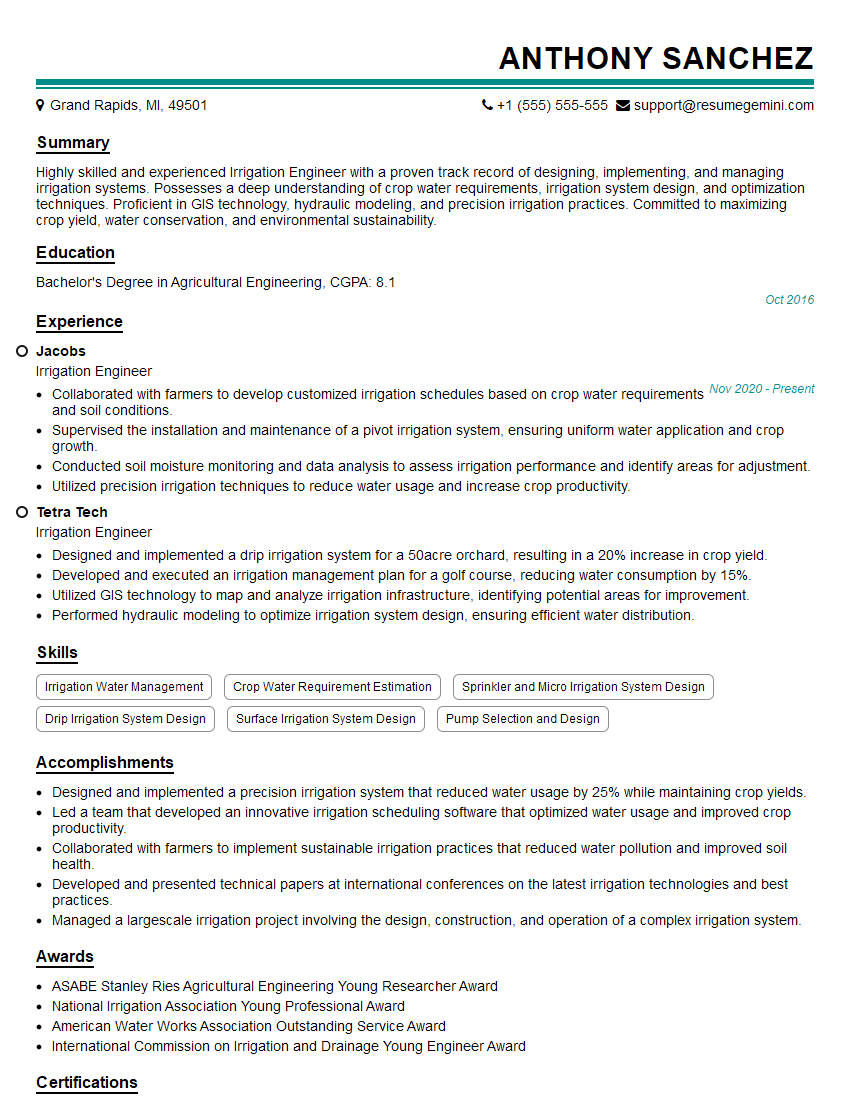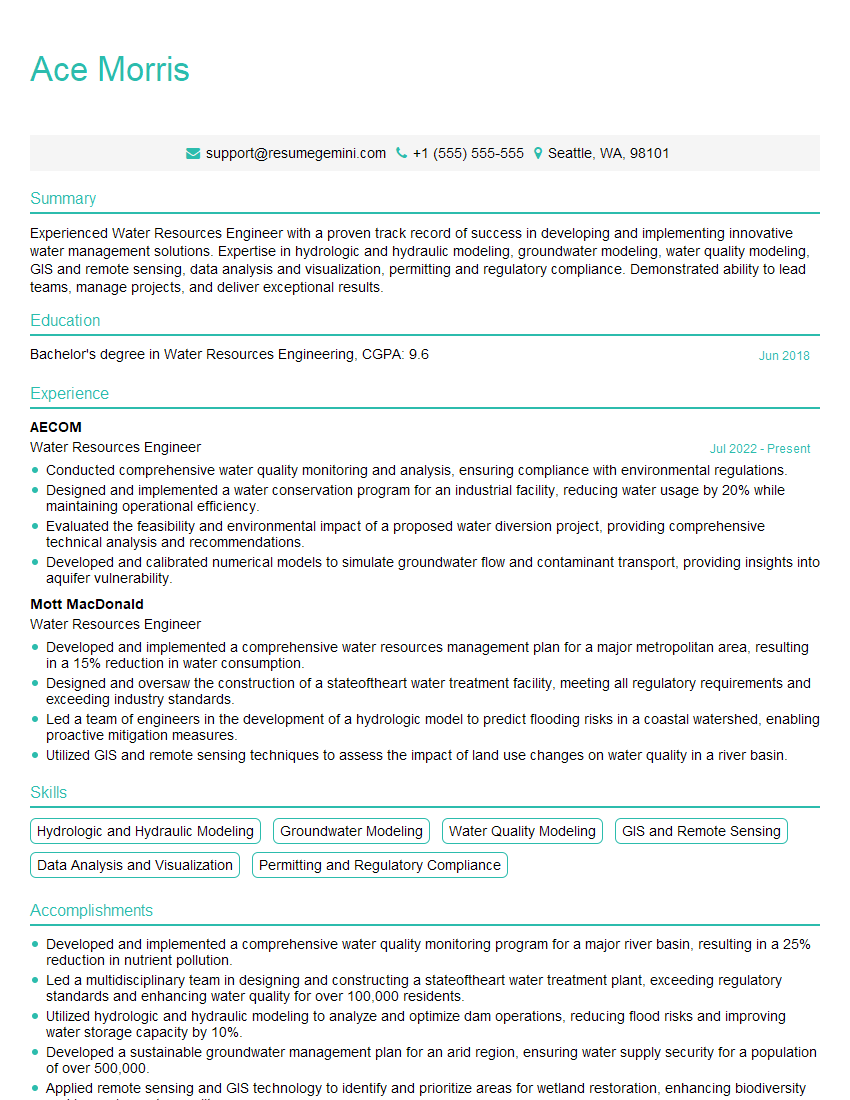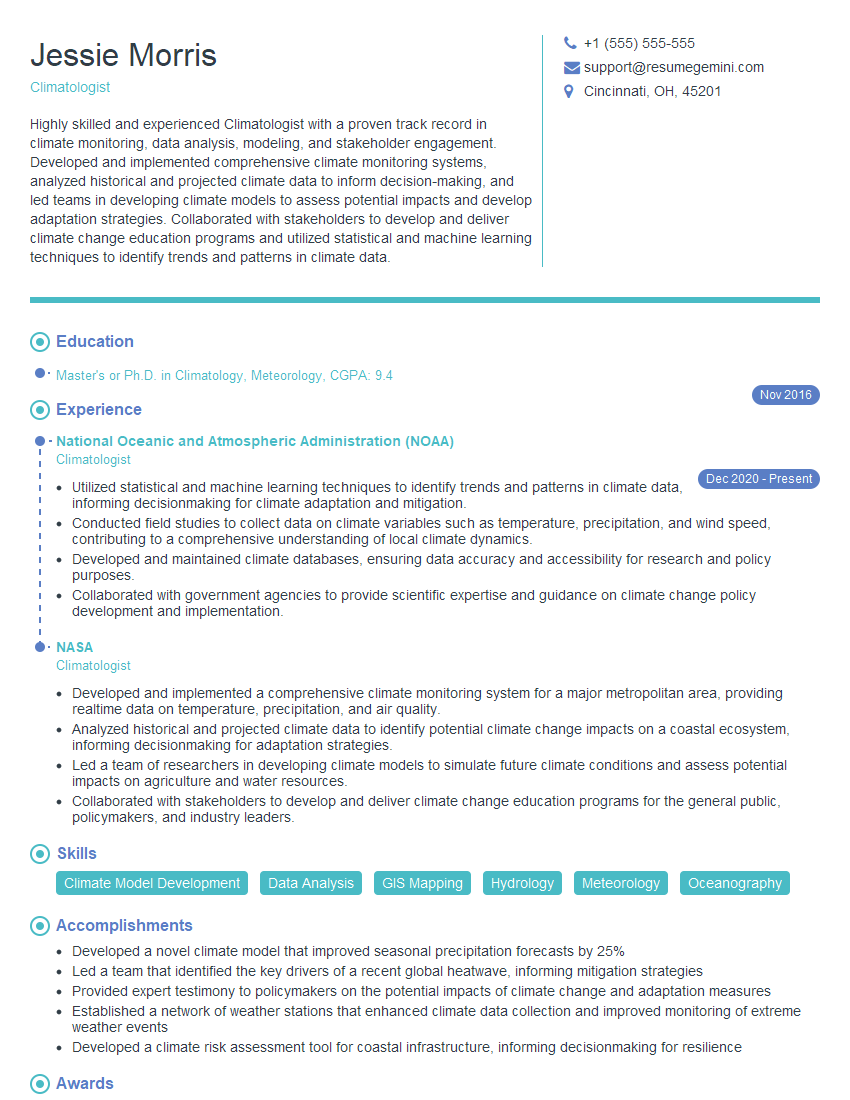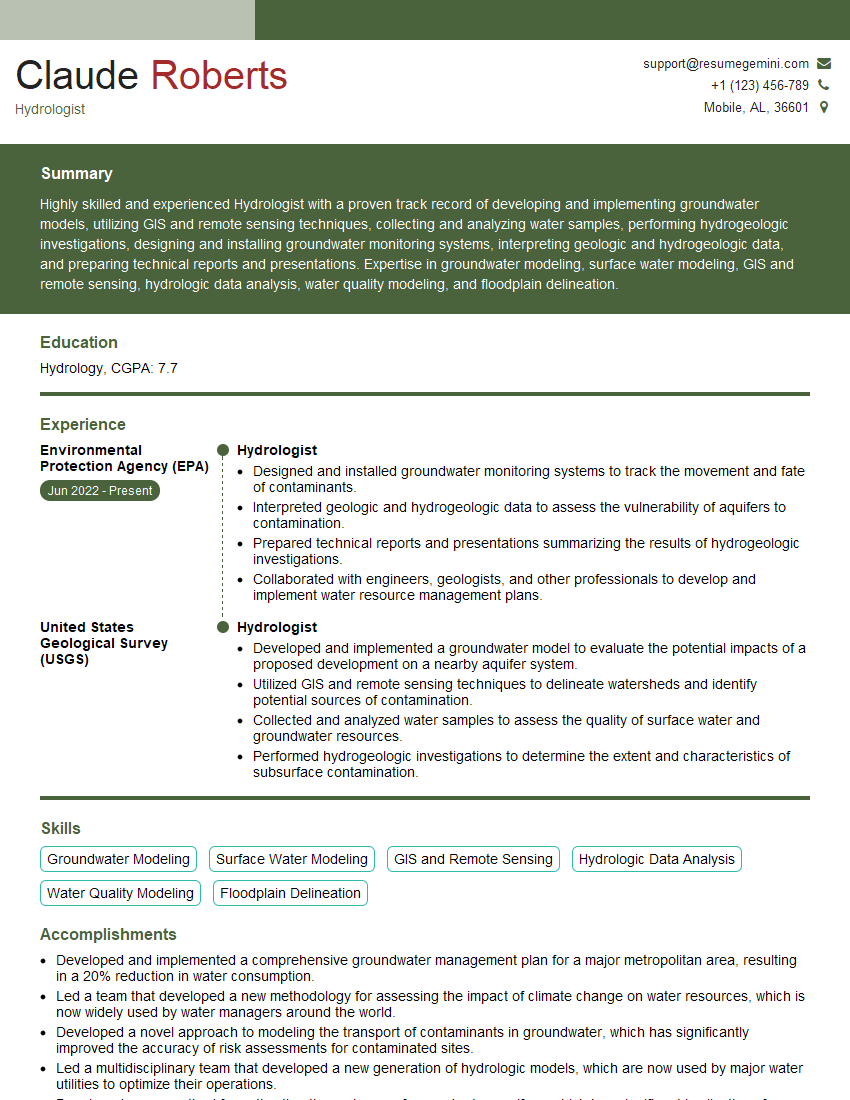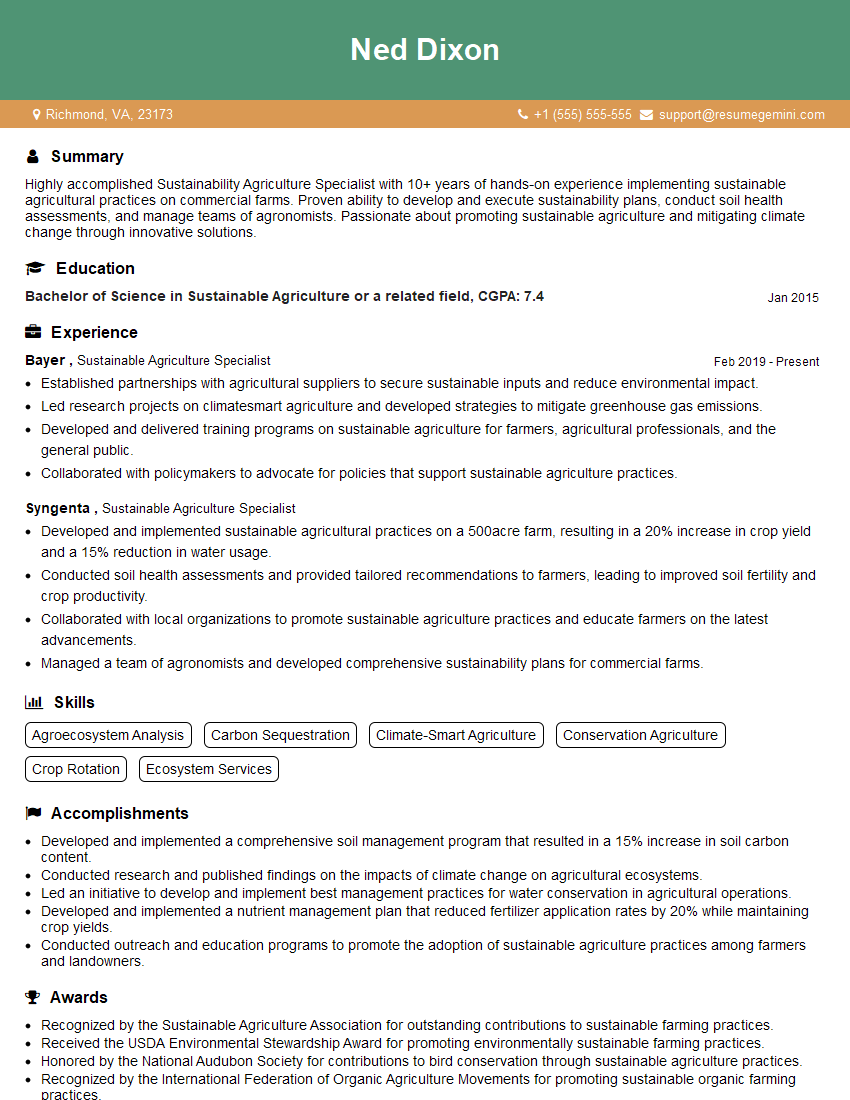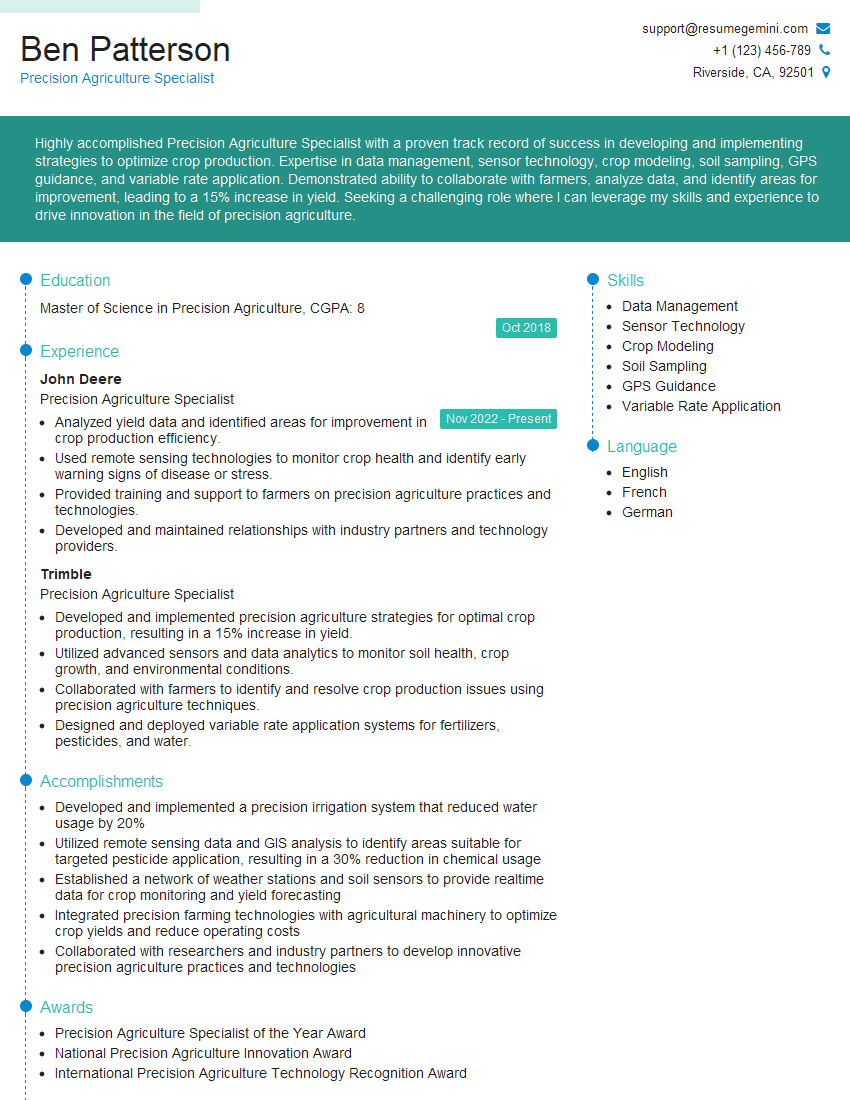Interviews are opportunities to demonstrate your expertise, and this guide is here to help you shine. Explore the essential Evapotranspiration interview questions that employers frequently ask, paired with strategies for crafting responses that set you apart from the competition.
Questions Asked in Evapotranspiration Interview
Q 1. Explain the process of evapotranspiration.
Evapotranspiration is the combined process of evaporation from the land surface and transpiration from plants. Imagine a giant, natural water cycle operating locally. Evaporation is the transformation of liquid water into water vapor, directly from soil, puddles, or other water bodies. Transpiration, on the other hand, is the process by which plants release water vapor through tiny pores on their leaves called stomata. Think of it as plants ‘breathing out’ water. These two processes work together to move water from the earth’s surface to the atmosphere.
The process begins with water entering the soil. Plants absorb this water through their roots and transport it upwards. Some of this water is used for photosynthesis and other metabolic processes, but a significant portion is lost to the atmosphere through transpiration. Simultaneously, water from the soil surface and any exposed water bodies evaporates. The combined effect of evaporation and transpiration is evapotranspiration, a crucial component of the hydrological cycle and weather patterns.
Q 2. Describe the difference between potential and actual evapotranspiration.
Potential evapotranspiration (PET) represents the maximum amount of water that could be evapotranspired under ideal conditions – unlimited water supply and favorable environmental factors. It’s like the theoretical upper limit. Actual evapotranspiration (AET), in contrast, is the amount of water that actually is evapotranspired, considering the limitations imposed by factors such as soil moisture availability and atmospheric conditions. It’s the real-world outcome.
Imagine a lush green field. PET would describe the water loss if the field were perpetually saturated. AET, however, reflects the actual water loss considering the soil might dry out during periods of drought or limited rainfall. The difference between PET and AET highlights the impact of water scarcity on the water cycle.
Q 3. What are the main factors influencing evapotranspiration?
Many factors influence evapotranspiration. They can be broadly categorized into climatic and soil factors.
- Climatic Factors: These include temperature, solar radiation (incoming sunlight), wind speed, and relative humidity. Higher temperatures, intense sunlight, strong winds, and low humidity all contribute to increased evapotranspiration.
- Soil Factors: Soil moisture content plays a vital role. A dry soil severely limits AET, regardless of climatic conditions. Soil type also matters; sandy soils drain quickly, reducing water availability for both evaporation and plant uptake. Finally, the presence of vegetation cover significantly influences evapotranspiration. Different plant types have varying transpiration rates.
- Other Factors: In addition to the above, factors such as altitude, topography, and even the presence of snow cover or ice can play a role in local evapotranspiration rates.
Q 4. How does temperature affect evapotranspiration?
Temperature significantly affects evapotranspiration. Higher temperatures increase the vapor pressure deficit (the difference between the actual water vapor pressure and the saturation water vapor pressure), driving the evaporation process. Warmer temperatures also increase plant metabolic activity, leading to higher transpiration rates. Think of a hot summer day: water evaporates quickly from puddles and plants wilt due to water stress because of rapid transpiration.
As a simple example, consider two identical fields, one under 25°C and the other under 35°C. The hotter field will have considerably higher evapotranspiration rates due to the enhanced evaporation and increased plant activity.
Q 5. How does wind speed affect evapotranspiration?
Wind speed has a direct impact on evapotranspiration. Strong winds remove the moist air near the surface, reducing the humidity and creating a steeper vapor pressure gradient. This gradient accelerates the movement of water vapor from the surface into the atmosphere. Imagine a clothesline: clothes dry faster on a windy day because the wind removes the moist air surrounding the clothes, allowing more moisture to evaporate.
Similarly, strong winds increase the rate of evapotranspiration by constantly replacing saturated air near the land surface with drier air, thus enhancing the evaporation and transpiration processes.
Q 6. How does humidity affect evapotranspiration?
Humidity, or the amount of water vapor already present in the air, inversely affects evapotranspiration. High humidity means the air is already close to saturation, making it harder for additional water vapor to evaporate and transpire. It’s like trying to add more water to a glass that’s almost full – it’s difficult.
Low humidity, on the other hand, creates a large vapor pressure deficit, accelerating evapotranspiration. A dry day will result in much higher evapotranspiration than a humid day, even if all other factors remain constant.
Q 7. Explain the role of soil moisture in evapotranspiration.
Soil moisture is the primary driver of actual evapotranspiration (AET). If the soil is dry, plants cannot access sufficient water for transpiration, and evaporation from the soil surface is limited. This severely restricts AET, regardless of the potential (PET) driven by climate factors.
Think of a plant as a straw sucking water from the soil. If the soil is dry (the cup is empty), the plant wilts, reducing its transpiration. Similarly, a dry soil surface limits direct evaporation. Adequate soil moisture is essential for maximizing AET, especially in agriculture, where efficient water use is paramount.
Q 8. What are some common methods used to measure evapotranspiration?
Evapotranspiration (ET) measurement employs various methods, each with strengths and weaknesses. Direct methods measure the actual ET, while indirect methods estimate it based on related factors.
- Lysimeters: These are weighing containers filled with soil and plants, precisely measuring water loss through ET by monitoring weight changes. They are highly accurate but expensive and impractical for large-scale applications. Imagine a giant scale weighing a section of land – that’s essentially a lysimeter.
- Eddy Covariance: This sophisticated method measures the turbulent fluxes of water vapor and other gases between the land surface and atmosphere using fast-response sensors. It’s accurate but requires specialized equipment and expertise. Think of it as a highly sensitive wind sensor analyzing the air’s moisture content.
- Soil Water Balance: This indirect method tracks changes in soil moisture content over time to estimate ET. It’s simpler than others, but assumes no lateral water movement and relies on accurate soil moisture measurements.
- Evaporation Pans: These simple, relatively inexpensive pans of water measure evaporation, providing a rough estimate of ET. However, they are affected by factors like wind and pan characteristics, resulting in lower accuracy.
Q 9. Describe the Penman-Monteith equation and its components.
The Penman-Monteith equation is a widely used energy balance model that calculates ET. It integrates several factors influencing ET into a single equation. The key components are:
- Net radiation (Rn): The difference between incoming and outgoing radiation. It’s the energy driving the ET process.
- Slope of the saturation vapor pressure curve (Δ): This represents the rate of change in saturation vapor pressure with temperature. It shows how quickly the air can hold moisture as temperature rises.
- Psychrometric constant (γ): This relates the air’s vapor pressure to its temperature. It accounts for the air’s capacity to hold moisture.
- Air temperature (T): Affects vapor pressure and thus the movement of water vapor.
- Wind speed (u): Influences the rate at which water vapor is transported away from the surface.
- Air vapor pressure (ea): The amount of water vapor already in the air. High values indicate less evaporative potential.
- Surface resistance (rs): Represents the plant’s resistance to water vapor flow from the leaf to the atmosphere. It’s affected by stomatal conductance (how open plant’s pores are). A high rs means the plant is struggling to lose water.
The equation balances energy available for ET with the atmospheric demand for water vapor, considering both energy and aerodynamic factors.
Q 10. Explain the FAO-56 Penman-Monteith equation.
The FAO-56 Penman-Monteith equation is a standardized version of the Penman-Monteith equation, widely used for irrigation scheduling and other agricultural applications. The main difference from the general Penman-Monteith equation lies in its use of readily available weather data and simplified calculation procedures. It employs standard meteorological variables and provides a more practical approach for widespread applications.
FAO-56 simplifies some aspects (like calculating surface resistance) and provides default values or easy-to-use methods for estimating the key components to make it applicable even with limited data. This simplifies the process for growers and water managers who may not have access to specialized equipment or intricate weather datasets. While it is simplified, it still provides a reliable estimate of ET in many agricultural settings.
Q 11. How do you estimate evapotranspiration using remote sensing data?
Remote sensing uses satellite and aerial imagery to estimate ET over large areas. This is particularly useful for monitoring water use in agriculture and for assessing regional drought conditions. Several approaches exist:
- Surface temperature based methods: These correlate land surface temperature (LST) with ET, using the principle that higher LST indicates higher ET, but the relation is not linear and needs calibration with ground measurements.
- Energy balance methods: These leverage remotely sensed data on radiation, surface temperature, and other parameters to calculate ET components in the energy balance equation.
- Vegetation indices: The Normalized Difference Vegetation Index (NDVI), for example, reflects vegetation health and can be used to estimate ET. Lush vegetation typically has higher ET.
These methods often involve complex algorithms and require calibration using ground-based measurements to improve accuracy. The choice of the best method depends on the availability of data and the specific application.
Q 12. What are the limitations of different evapotranspiration estimation methods?
Each ET estimation method faces limitations:
- Lysimeters: Expensive, not scalable, may not fully represent the surrounding environment.
- Eddy covariance: High cost, requires specialized expertise, susceptible to instrument errors and atmospheric conditions.
- Soil water balance: Assumes no lateral water flow, relies on accurate soil moisture measurements, can be inaccurate for deep-rooted plants.
- Evaporation pans: Sensitive to pan characteristics, wind, and surrounding environment, provides only a rough estimate.
- Remote sensing methods: Atmospheric effects can introduce errors, calibration is crucial, spatial resolution may be insufficient for small areas, cloud cover can hamper data acquisition.
- Penman-Monteith equation (and derivatives): Accurate estimates require accurate weather data. Input parameters like rs (surface resistance) and other plant-related variables are often estimated, introducing uncertainties.
Understanding these limitations is essential for selecting the appropriate method and interpreting results.
Q 13. How can evapotranspiration data be used in irrigation scheduling?
Evapotranspiration data is crucial for efficient irrigation scheduling. By knowing the amount of water lost through ET, farmers can determine the precise amount of supplemental irrigation needed to maintain optimal crop water status. This approach prevents over-irrigation, which wastes water and can lead to soil salinity, while avoiding under-irrigation, which reduces crop yields.
Irrigation scheduling based on ET uses methods like the Crop Evapotranspiration (ETc), which accounts for crop-specific factors. This involves using ET data alongside crop coefficients (Kc) to determine the actual ETc for a specific crop at a given growth stage. The difference between ETc and the amount of rainfall received represents the irrigation requirement.
Precision irrigation systems, controlled by ET data and weather forecasts, further optimize water usage and minimize losses.
Q 14. Describe the concept of water balance and its relation to evapotranspiration.
The water balance describes the relationship between water inputs (precipitation, irrigation) and outputs (ET, runoff, deep percolation) within a given system. Evapotranspiration is a major component of the water balance, often being the largest water output in many ecosystems.
The basic water balance equation is: Precipitation + Irrigation - Evapotranspiration - Runoff - Deep Percolation = Change in Soil Water Storage
Understanding the water balance allows us to track water movement, estimate water availability, and optimize water resources management. Accurate ET measurement is critical for correctly estimating other components of the water balance and predicting potential water shortages or excesses.
For instance, in drought management, accurate ET data helps in assessing the severity of the drought and predicting the impact on water resources. In reservoir management, understanding ET is essential for predicting water availability and planning water releases.
Q 15. How does evapotranspiration contribute to the hydrological cycle?
Evapotranspiration (ET) is the combined process of evaporation from the land surface and transpiration from plants, acting as a crucial component of the hydrological cycle. Think of it as the Earth’s ‘breathing’: it’s the process by which water moves from the land surface and vegetation back into the atmosphere.
In the hydrological cycle, ET represents a significant outflow of water from terrestrial systems. Precipitation falling on land is either stored in the soil, flows as runoff into rivers and streams, or is lost to the atmosphere through ET. The amount of ET influences soil moisture levels, streamflow volumes, and groundwater recharge. For example, a forest with high ET rates will have lower surface runoff compared to a bare, paved area where ET is significantly less.
- Evaporation: The transformation of liquid water into water vapor from soil, water bodies, and even the surfaces of leaves.
- Transpiration: The process where plants absorb water through their roots, transport it to their leaves, and release it as water vapor into the atmosphere through tiny pores called stomata.
Understanding ET is vital for water resource management because it helps predict water availability and plan for irrigation needs in agriculture, and managing water levels in reservoirs.
Career Expert Tips:
- Ace those interviews! Prepare effectively by reviewing the Top 50 Most Common Interview Questions on ResumeGemini.
- Navigate your job search with confidence! Explore a wide range of Career Tips on ResumeGemini. Learn about common challenges and recommendations to overcome them.
- Craft the perfect resume! Master the Art of Resume Writing with ResumeGemini’s guide. Showcase your unique qualifications and achievements effectively.
- Don’t miss out on holiday savings! Build your dream resume with ResumeGemini’s ATS optimized templates.
Q 16. Explain the impact of climate change on evapotranspiration patterns.
Climate change significantly impacts evapotranspiration patterns, primarily through alterations in temperature, precipitation, and atmospheric humidity. Rising global temperatures increase the energy available for evaporation, leading to higher ET rates, especially in regions where water is readily available. Imagine a hotter day – your sweat evaporates quicker, demonstrating increased evaporation rates with higher temperature.
Changes in precipitation patterns also have a profound effect. Increased frequency and intensity of droughts reduce soil moisture, thereby limiting transpiration and potentially lowering overall ET. Conversely, increased rainfall can lead to higher ET rates, especially in well-vegetated areas, though this can depend on soil characteristics. For instance, excessively high rainfall could lead to saturation and reduced ET in some soils.
Increased atmospheric CO2 concentrations can have a complex impact. While initially stimulating plant growth and potentially enhancing transpiration, prolonged exposure and other climate change effects can lead to reduced water-use efficiency and potentially altered ET patterns. The interaction of all these factors makes predicting changes in ET complex, and often requires sophisticated models.
Q 17. How can evapotranspiration be reduced to conserve water?
Reducing evapotranspiration to conserve water involves strategies that limit water loss to the atmosphere. These methods focus on either reducing evaporation from soil surfaces or minimizing plant transpiration.
- Mulching: Applying a layer of organic or inorganic material (like straw, plastic, or gravel) over the soil reduces evaporation by shading the soil and reducing wind speed. This is a common practice in agriculture.
- Improved irrigation techniques: Efficient irrigation systems like drip irrigation or micro-sprinklers deliver water directly to plant roots, minimizing evaporation losses compared to flood irrigation. Water is a precious resource and this method minimizes waste.
- Water-wise landscaping: Selecting drought-tolerant plants reduces the need for irrigation, thereby lowering ET. In urban areas, using drought-resistant landscaping can significantly decrease water consumption.
- Cover crops: Planting crops that cover the soil between main crops reduces evaporation and erosion, effectively improving water conservation.
- Windbreaks: Planting trees or shrubs as windbreaks reduces wind speed, decreasing evaporation rates.
The effectiveness of these methods depends on local climate conditions, soil type, and vegetation.
Q 18. What are some strategies for improving water use efficiency in agriculture considering evapotranspiration?
Improving water use efficiency in agriculture, while considering evapotranspiration, requires integrated strategies that enhance water availability to plants and minimize water loss. This involves both management practices and technological solutions.
- Precision irrigation: Utilizing soil moisture sensors and weather data to tailor irrigation schedules to specific crop needs and soil conditions. This method avoids overwatering, which can lead to runoff and leaching, while also ensuring adequate moisture for optimal growth.
- Crop selection and breeding: Choosing drought-tolerant crop varieties that have high water-use efficiency. Genetic improvements can lead to significant gains in this area.
- Improved nutrient management: Optimizing nutrient application improves plant health and water use efficiency. Healthy plants tend to be more efficient in water uptake and transpiration.
- Soil health management: Improving soil structure through practices like no-till farming enhances water infiltration and retention, reducing evaporation and ensuring water is readily available to plants.
- Agroforestry: Integrating trees into agricultural systems can modify microclimates and potentially reduce ET through shading and wind reduction. This practice is beneficial in drier climates.
It’s crucial to understand that the most effective approach often involves a combination of these strategies tailored to the specific context.
Q 19. How do you account for spatial variability in evapotranspiration estimations?
Accounting for spatial variability in evapotranspiration estimations is crucial because ET rates vary significantly across landscapes due to differences in land cover, soil type, topography, and microclimates. Ignoring this variability can lead to inaccurate water resource assessments and inefficient water management.
Several methods are employed to address spatial variability:
- Remote sensing: Utilizing satellite imagery and aerial photography to measure ET across large areas. These methods provide spatially explicit ET estimates, but require careful calibration and validation.
- Geographic Information Systems (GIS): Integrating various data layers (e.g., land cover, soil type, elevation) within a GIS framework to model and map ET variability. This allows for integrating various sources of information about ET patterns across a region.
- In-situ measurements: Deploying weather stations and eddy covariance systems across the study area to collect detailed ET measurements at specific locations. These highly accurate measurements are then used to calibrate and validate models.
- Upscaling techniques: Using data from smaller-scale measurements or models to estimate ET at larger scales. This can involve statistical methods or process-based modelling techniques to extrapolate from more detailed points.
A combination of these methods usually provides the most robust and reliable estimation of spatially-variable ET.
Q 20. Describe different types of evapotranspiration models and their applications.
Various evapotranspiration models exist, each with strengths and weaknesses depending on the application and data availability. They are broadly categorized as:
- Empirical models: These models rely on statistical relationships between readily available weather data (temperature, humidity, wind speed, solar radiation) and observed ET. They are relatively simple to use but often lack mechanistic detail and are limited by the accuracy of the weather data and underlying assumptions. Examples include the Penman-Monteith equation, a widely used model that combines energy balance and aerodynamic considerations, and simpler methods like Hargreaves.
- Process-based models: These models simulate the physical processes involved in ET, such as energy balance, stomatal conductance, and soil water dynamics. They are more complex and require extensive input data, including soil properties, vegetation characteristics, and detailed meteorological information. They are more mechanistically robust but can be computationally intensive. Examples include the Soil-Water-Atmosphere-Plant (SWAP) model and Variable Infiltration Capacity (VIC) models.
Applications:
- Irrigation scheduling: Empirical and process-based models inform when and how much to irrigate.
- Water resource management: Predicting water availability in rivers and reservoirs.
- Climate change impact assessment: Projecting future changes in water resources and regional water balances.
- Ecosystem modelling: Simulating water and carbon cycles in ecosystems.
The choice of model depends on data availability, computational resources, and the desired level of detail and accuracy.
Q 21. How can you validate evapotranspiration estimations?
Validating evapotranspiration estimations is crucial for ensuring their reliability and accuracy. This usually involves comparing model outputs with independent measurements of ET.
- Eddy covariance measurements: These provide direct measurements of ET fluxes using advanced instrumentation that measures atmospheric turbulence. These measurements are considered the ‘gold standard’ for ET validation but are expensive and logistically challenging. They provide direct measurement of the flux of water vapor.
- Lysimeter measurements: These involve weighing large soil columns to precisely determine the amount of water lost through ET. This method is highly accurate for a limited area, providing a valuable ground-truthing dataset.
- Soil moisture measurements: Changes in soil moisture content can be used to estimate ET, providing an indirect method for validation.
- Comparison with other models: Comparing the results of different ET models can provide insights into the uncertainties associated with the estimates. This intercomparison highlights the uncertainties inherent in the different methods.
Statistical metrics such as root mean square error (RMSE), Nash-Sutcliffe efficiency (NSE), and R-squared are often used to quantify the agreement between model outputs and validation data. Thorough validation is critical to ensure the model is suitable for its intended application.
Q 22. Discuss the importance of evapotranspiration in drought monitoring.
Evapotranspiration (ET), the combined process of evaporation from the land surface and transpiration from plants, is a crucial indicator in drought monitoring. Think of it as the planet’s ‘sweating’ – the amount of water leaving the land and entering the atmosphere. During droughts, ET rates significantly decrease because there’s less water available in the soil for plants to use and less surface water for evaporation. Monitoring ET helps us understand the severity and extent of a drought. For example, a prolonged period of significantly reduced ET compared to historical averages indicates a developing or existing drought. We can use ET data to trigger drought warnings, allocate water resources efficiently, and assess the impact on agriculture and ecosystems.
Specifically, we look for anomalies – deviations from the expected ET based on historical data and climatic conditions. A consistent, below-average ET coupled with reduced precipitation provides strong evidence of drought conditions. This information allows water managers to implement water restrictions, farmers to adjust irrigation strategies, and policymakers to enact drought mitigation plans.
Q 23. Explain the relationship between evapotranspiration and crop yields.
Evapotranspiration is directly linked to crop yields because it represents the water demand of plants. Plants require water for photosynthesis and other metabolic processes, and the amount of water they lose through transpiration significantly impacts their growth and productivity. Sufficient ET indicates healthy plant growth and adequate water availability, resulting in higher yields. Conversely, insufficient ET due to water stress leads to reduced growth, lower yields, and potentially crop failure. Think of it like this: if a plant doesn’t get enough water to ‘sweat’ normally, it won’t thrive.
Agricultural practices aim to optimize ET through efficient irrigation techniques, selecting drought-resistant crop varieties, and implementing soil management practices that enhance water retention. Monitoring ET helps farmers fine-tune their irrigation scheduling, preventing both overwatering (leading to water wastage and potential nutrient leaching) and underwatering (leading to reduced yields).
Q 24. How can evapotranspiration data inform water resource management decisions?
Evapotranspiration data is invaluable for informed water resource management decisions. By understanding the water demand of various ecosystems and agricultural lands, we can efficiently allocate available water resources. For example, in a region facing water scarcity, ET data can inform decisions regarding water allocation for different sectors, such as agriculture, industry, and domestic use, ensuring a balance between needs and availability.
Furthermore, ET data helps in designing efficient irrigation systems. Knowing the actual ET of a crop helps farmers precisely apply irrigation, minimizing water wastage. This data is also essential for developing reservoir management strategies, planning for water infrastructure, and assessing the impacts of climate change on water resources. It allows for proactive strategies to mitigate risks associated with water scarcity and ensure sustainable water management practices.
Q 25. Describe the challenges in accurately measuring evapotranspiration in different environments.
Accurately measuring evapotranspiration across diverse environments presents significant challenges. The complexity arises from the many factors influencing ET, including solar radiation, temperature, humidity, wind speed, soil moisture, and vegetation characteristics. These factors vary greatly depending on the location (e.g., arid desert vs. humid forest). Measuring ET directly is difficult and requires expensive, sophisticated equipment like lysimeters (which measure water loss from a soil column) or eddy covariance systems (which measure turbulent fluxes of heat and water vapor). These are not practical for large-scale monitoring.
Additional challenges include the spatial variability of ET within a given area, making it difficult to extrapolate measurements from point observations to a larger region. Furthermore, data availability and accessibility can be limited in many parts of the world, hindering our ability to understand and manage water resources globally.
Q 26. What are the advantages and disadvantages of using different ET estimation methods?
Various methods exist for estimating ET, each with advantages and disadvantages. Simple methods like pan evaporation use an evaporation pan to estimate ET, but they often overestimate actual ET, particularly in areas with significant vegetation. Energy balance methods, which consider factors like radiation, temperature, and humidity, provide more accurate results but require detailed meteorological data. Remote sensing techniques, using satellite imagery, allow for large-scale ET estimation, but their accuracy can be affected by cloud cover and atmospheric conditions. Finally, crop coefficient methods use empirically derived coefficients to adjust reference ET values for specific crops, providing a relatively simple yet effective approach for agricultural applications.
The choice of method depends on factors such as the desired accuracy, data availability, budget, and the specific application. For example, a large-scale regional water management plan might use remote sensing data, while a farmer might use a crop coefficient approach to manage irrigation for a specific field.
Q 27. How can advancements in technology improve our understanding and measurement of evapotranspiration?
Advancements in technology are significantly improving our understanding and measurement of evapotranspiration. Remote sensing, specifically with higher-resolution satellite imagery and improved algorithms, enables more accurate and spatially detailed ET estimations over large areas. Unmanned aerial vehicles (UAVs) equipped with sensors provide high-resolution data over smaller areas, allowing for detailed investigation of ET variability within fields or ecosystems. The development of advanced weather models incorporates more sophisticated representations of ET processes, leading to improved weather forecasting and drought prediction.
Furthermore, machine learning and artificial intelligence are being employed to analyze large datasets of ET information, identify patterns, and improve ET prediction models. These advancements are essential for developing more robust and reliable ET estimation methods and ultimately for enhancing our ability to monitor, manage, and conserve our valuable water resources.
Key Topics to Learn for Evapotranspiration Interview
- Fundamentals of Evapotranspiration: Understand the process, its components (potential and actual evapotranspiration), and the driving forces behind it. Explore the differences between evaporation and transpiration.
- Energy Balance Methods: Learn how energy balance equations are used to estimate evapotranspiration, including the Bowen ratio and energy balance methods. Understand their limitations and applicability.
- Aerodynamic Methods: Master the principles behind aerodynamic methods, such as the Penman-Monteith equation, and be prepared to discuss their advantages and disadvantages compared to other methods.
- Empirical Equations: Familiarize yourself with commonly used empirical equations for estimating evapotranspiration (e.g., Blaney-Criddle, Hargreaves). Understand their assumptions and limitations.
- Evapotranspiration and Climate Change: Discuss the impacts of climate change on evapotranspiration patterns and the implications for water resources management.
- Practical Applications: Be ready to discuss applications of evapotranspiration in agriculture (irrigation scheduling), hydrology (water balance modeling), and ecology (ecosystem studies).
- Instrumentation and Measurement Techniques: Understand different methods for measuring evapotranspiration, including lysimeters, eddy covariance systems, and remote sensing techniques. Be able to compare their strengths and weaknesses.
- Modeling Evapotranspiration: Familiarize yourself with different evapotranspiration models and their applications in various fields. Be prepared to discuss model inputs, outputs, and limitations.
- Water Stress and Plant Response: Understand the relationship between evapotranspiration, water stress, and plant physiological responses.
Next Steps
Mastering evapotranspiration opens doors to exciting careers in agriculture, hydrology, environmental science, and climate research. A strong understanding of these concepts is highly valued by employers. To maximize your job prospects, create an ATS-friendly resume that effectively showcases your skills and experience. ResumeGemini is a trusted resource that can help you build a professional resume tailored to your specific career goals. Examples of resumes tailored to the Evapotranspiration field are available within ResumeGemini to help guide your creation.
Explore more articles
Users Rating of Our Blogs
Share Your Experience
We value your feedback! Please rate our content and share your thoughts (optional).
What Readers Say About Our Blog
good
